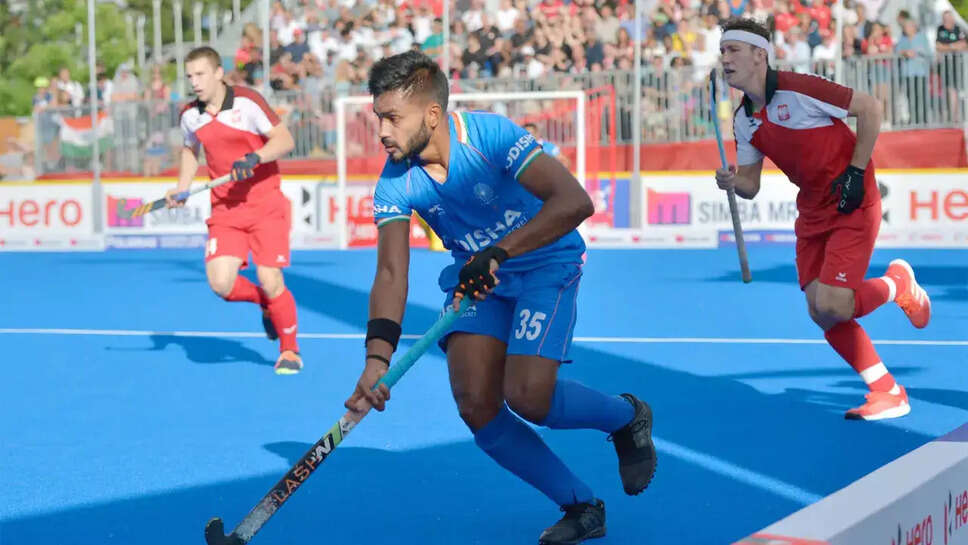India Serve Up Heavy‑Metal Hockey—and Again Falter at the Finish Line Against Netherlands

In recent international fixtures, India’s men’s hockey team has electrified audiences with a ferocious, all‑guns‑blazing style fans are calling “heavy‑metal hockey.” High tempo, relentless pressing, and high-risk attacking have turned matches into adrenaline‑charged theater. Yet against elite opponents like the world‑beating Netherlands, the performance—though heart‑stopping at times—falls just short at the final whistle. The contrast has become painfully clear: India may roar like thunder, but the crown still eludes them.
🎸 Volume Turned to Eleven: High-Octane Style
From the first whistle, India’s intent is unmistakable: move fast, strike fast, break fast. Midfielders launch the ball forward with urgency, while forwards hunt down every loose touch. Defenders push high into the Dutch half to sustain pressure. This isn’t conservative hockey—it’s full throttle, gas pedal to the floor.
Crowds in stadiums are electrified. A routine outlet becomes a heart‑racing break, a long ball cuts lines, and the crowd rises to its feet. India’s survival instinct is murderously active—they press, they tackle, they sprint, in short bursts that leave opponents staggered.
And yet, the goal‑mouth remains elusive. Despite wave after wave of barrages, the ball just won’t cross the line.
⚙️ Brutal Churn with Tactical Sharpness
This isn’t blind aggression. Coaches have layered India’s high‑octane game with smarts: passing sequences engineered to overload the flanks, midfield rotations that drag opposition out of shape, and overlap runs designed for quick link‑ups.
Strikingly, India is executing more purposeful third‑phase moves—those final complex passes—than ever before. Ball carriers dribble wide to pull defenders, recycle quickly to feet, and try the emergent stick feed at the top of the circle. But that final touch, that flash of genius needed in tight spaces, too often dribbles away.
And even when a shot is made, Indian forwards find themselves tangled in rebounds, trapped at odd angles, or blocked in mass traffic. Against mid‑tier opponents, these tactics yield results. Against the Netherlands, they’re just inches short.
⛔ Fine Margins at the Circle
In matches against the Dutch, India has recorded 10‑12 circle entries a game—double what it used to register in earlier years. Execution, however, trips them up.
Dutch defenders are patient and physical, clogging passing lanes and constantly shifting bodies to obstruct sight lines. Indian shots are often hurried, misbroken, or blocked by the first defender. A pass sacks at the sticks. A drag flick spins wide.
Occasional brilliance surfaces: a run‑reverse flick, a one‑touch tip‑in. But these moments are fleeting, and Netherlands always rebounds. Those brief pangs of hope fade without the sustained execution needed to win.
🚨 Goal Threat: Too Often Evaporates
India has produced over 20 penalty corners per match across recent tournaments, but success rates hover around 20–25%. High‑pressure situations frequently yield short passes instead of decisive flicks. Dutch circle entry counts are much lower—but they’re clinical. One or two chances, and they bury them.
When India conceded, it came from set pieces too—a deflected shot, a slip, a rebound. And once the scoreboard opened, India chased the game. The high‑metal performance became frantic rather than effective.
🤝 Defensive Battles Meet Momentary Lapses
India’s defensive unit, too, has adopted a marching band mentality—pressing forward to disrupt Dutch buildup. Yet without a clear finish in hand, that press can turn easily into vulnerability.
A missed tackle on the edge of India’s D can lead to a full circle break from Holland, and within seconds a rebound can be slotted home. Coupled with turnover‑heavy midfield, India self‑creates moments where the Dutch can pounce—no more than a single misstep needed.
🧠 Mental Tug-of-War and Game Management
It’s clear that India’s young side is made of steel, but they still crave composure when the stakes peak. Under relentless Dutch assault after conceding, India’s lines flatten, and desperation sets in as players chase individual glory rather than team shape.
Contrast that with Holland—they press only until the moment of regain, then shift to a patient probing game, forcing India to chase. India want to retake tempo, but do so in ways that generate gaps. It becomes a trap.
India’s coaches are aware—what they need now is not louder drumming, but quieter rhythm when the pause hits. Especially in tournament encounters, game management matters as much as raw energy.
🌱 The Small Upside: Growth in Heavy Metal
Despite painful losses, this era has a silver lining.
-
Physical intensity: India now out‑runs more mantled rivals—last year’s stamina crisis seems gone.
-
Tactical sophistication: Runs are better timed, pressing trigger patterns more structured.
-
Confidence building: Younger players believe they can match the world’s best physically and technically.
They’re exploding out of hockey’s basement, now jostling at the ceiling. Losses hurt—but suggest position change.
🔭 What Could Turn Tides
1. Circle instinct and execution
Answer: more rehearsed dodge-flick combos, better communication, more reflex training.
2. Game control after scoring
Smaller 5–10 minute phases of patient buildup, slowdown of tempo to break opposition, reset focus.
3. Cool-headed decision‑making
Mental‑skills coaching during chaos, breath drills, passing under pressure—which can help sustain composure.
🛠 Roof-Raising when Faced with the Best
India isn’t weak. They dominated midfield possession during this match, enjoyed momentary parity in speed, and even outshot the Dutch at certain junctures. But the world leaders—team of fine margins—do things smarter, not just louder.
India’s heavy‑metal approach gives them identity, brings energy, and wows crowds. What they lack is polish: circle chaos needs clarity, intensity needs direction.
🌌 Fanbase and Federation Response
Spectators are torn: they stand and cheer for every furious raid, but despair over missed opportunities. Social media features quick peals—“Close, yet so far” reads. Federation analysts are calling this a transitional phase—intensity is no longer the limiter. Now it’s delivery.
Coaching staff and selectors face commentary. Veterans suggest a mixed strategy: tempo-based heavy metal for 10 minutes, then more structured hockey to finish 3‑4‑0 priority moments.
🏅 Vision for Future Tournaments
-
Champions Trophy & Olympics: India wants to replicate grit, but add the tactical second wave needed to break open tight matches.
-
Under‑25 development: Teach finish techniques under fatigue, through repeated recovery drills and game‑intensity finishing training.
-
Mental fitness coaches: Bring in sports psychologists who train players to respond calmly after concession and in crunch moments.
🍂 A Narrative of Progress and Frustration
The truth is layered: India’s men’s hockey is in the process of rebooting its identity. They may lack years of experience, cohesion against pressure, and the instinctive calm of veterans—but what they offer is raw uplift, passion, and a rejuvenated style few want to face.
Really, it comes down to execution. They have built a new shape; they now must polish the angles.
Final Reflections
India’s “heavy‑metal hockey” is not a gimmick—it’s the sound of an old power trying to rewrite its anthem. The volume and ferocity are welcome, but now comes the glue: finishing, mental toughness, granular game sense.
Each defeat to the world No. 1 is a lesson. Each exiting cheer a note of hope. When India gets past the crash and burn of their own design to smoothly convert pressure into goals and defense, they will rediscover the podium.
